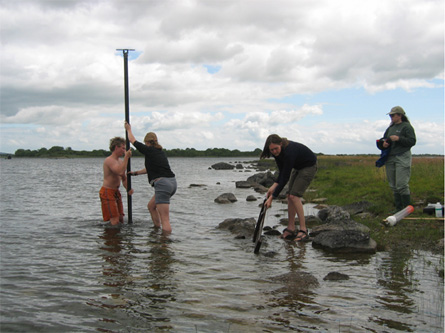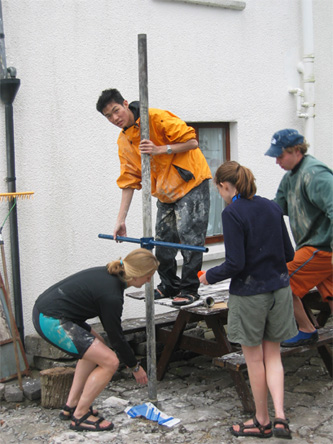Interpreting the Holocene Paleoclimate of Ireland through Chemical Analysis of Lake Sediments
Samantha Saalfield
Whitman College, Walla Walla, WA 99362
During July, 2003, I participated in a Keck Consortium project in Western Ireland. I worked with two professors (from Amherst College and the UMass Amherst) and four other students, taking water samples and sediment cores from a marl (carbonate) lake north of Galway. The cores are up to 2 meters in length, and are expected to represent deposition during the past 2000 years. Through a variety of analyses of these sediments, we hope to be able to paint a picture of the climate variations since the last glaciation in Western Ireland, which are thought to reflect the conditions in the North Atlantic in general.
My portion of the project involves doing chemical analysis of the samples, for a number of major and trace elements. I will be dissolving the dried, powdered sediments in weak acid and then using an atomic absorption spectrophotometer and an ultraviolet-visible spectrophotometer, in Whitman’s environmental chemistry lab, to measure these concentrations. Previously drawn correlations between metals concentrations and climatic conditions (precipitation and temperature) will aid in my interpretation.
Three other student research projects also came out of the larger project. A Trinity University (Texas) senior is doing paleontological analysis of our sediment cores, looking for population trends that could indicate past physical and chemical conditions in the lake. Hopefully, his data and mine can be combined into a coherent paleoclimatic model. Meanwhile, a geology major from Amherst College is developing a model that will help evaluate and improve the effectiveness of sediment analysis in interpreting paleoclimate, taking into account such variables as post-depositional dissolution and reprecipitation of the sediments. We hope to be able to use his model in interpreting our paleontological and chemical data. Another Amherst student is researching the role of microorganisms in carbonate precipitation, using the water samples we collected.


Questions or comments?
Return to Geology Department Home Page
Return to information on Whitman College